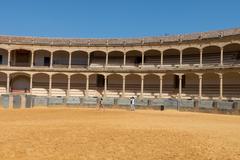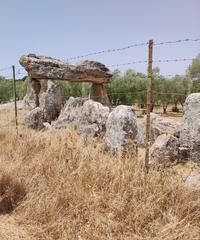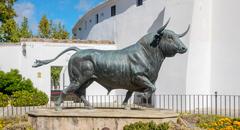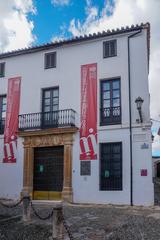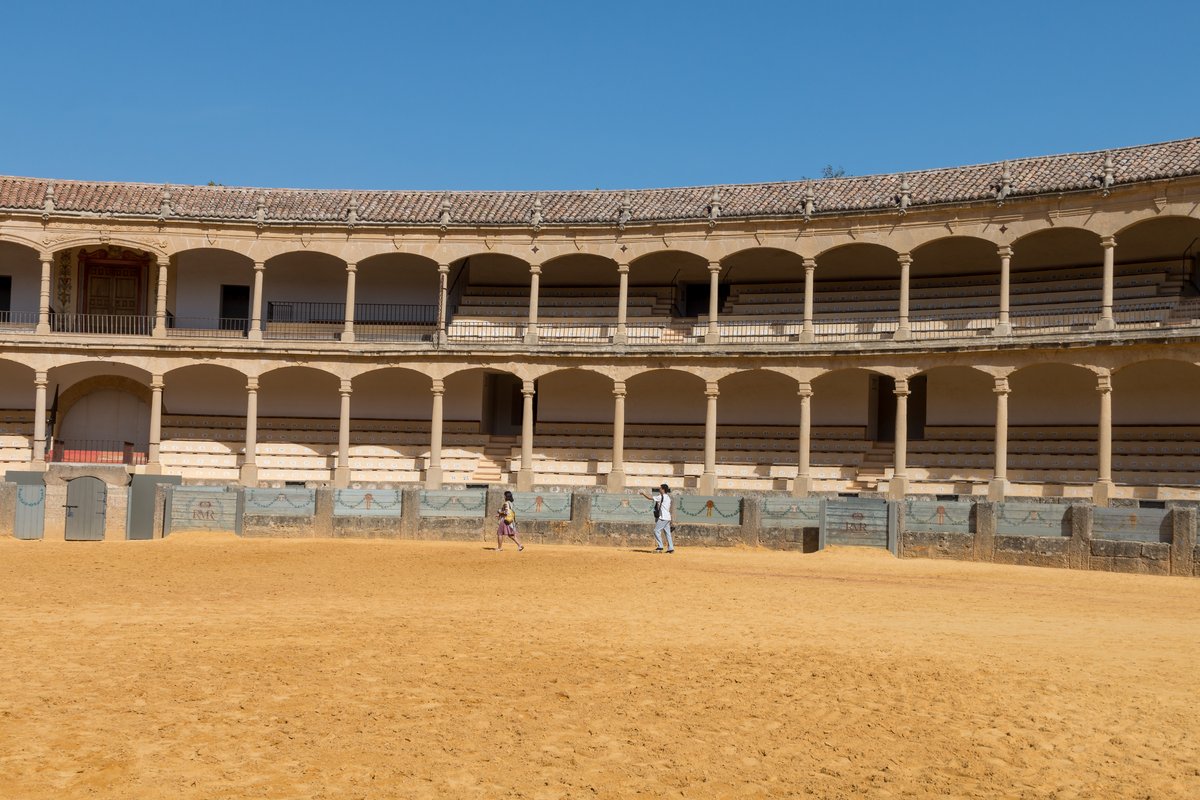
Plaza de Toros de Ronda: Visiting Hours, Tickets, and Historical Significance
Date: 15/06/2025
Introduction
Perched atop the dramatic cliffs of Ronda in Andalusia, the Plaza de Toros de Ronda is one of Spain’s oldest and most illustrious bullrings. This neoclassical monument is renowned not only for its architectural grandeur but also as the cradle of modern Spanish bullfighting. The site offers visitors a unique journey through the traditions, artistry, and history of Andalusian culture. Whether you are a history enthusiast, architecture lover, or cultural traveler, the Plaza de Toros de Ronda promises an immersive experience into the soul of Spain (explorial.com, wikipedia.org).
Table of Contents
- Introduction
- Origins and Construction
- Architectural Significance
- Evolution of Spanish Bullfighting
- Cultural and Social Importance
- Key Festivals and Modern Events
- Visiting Information: Hours, Tickets & Tours
- Frequently Asked Questions (FAQ)
- Conclusion
- References
Origins and Construction
The Plaza de Toros de Ronda was commissioned by the Real Maestranza de Caballería de Ronda, a historic chivalric order established in 1573. Construction began in 1779 under the guidance of architect José Martín de Aldehuela, who also designed Ronda’s iconic Puente Nuevo bridge. The bullring was inaugurated in 1785 with a celebrated festival, setting the stage for its enduring legacy in Spanish culture (explorial.com).
Architectural Significance
The bullring is a masterpiece of neoclassical design, featuring a perfectly circular arena 66 meters (216 feet) in diameter—making it one of the largest in Spain (wikipedia.org). The seating is arranged in two tiers, supported by 136 Tuscan columns that form 68 harmonious arches. The elegant Royal Box, with its Arabic-tiled sloping roof and wooden canopy, reflects the arena’s noble heritage. The main entrance is distinguished by two Tuscan columns, the royal shield, and a wrought-iron balcony, symbolizing the deep ties between Spanish nobility and bullfighting traditions (explorial.com). The arena accommodates approximately 5,000 spectators and retains much of its original character, offering a glimpse into the grandeur of 18th-century public architecture (bodegadonafelisa.com).
Evolution of Spanish Bullfighting
The Plaza de Toros de Ronda is celebrated as the birthplace of modern Spanish bullfighting. Under the influence of legendary matador Pedro Romero Martínez, bullfighting evolved from a horseback spectacle to the artful and codified practice performed on foot. Romero’s innovations brought a new level of artistry, bravery, and code of conduct to the sport, establishing standards that endure today (allaboutevesjourneys.com). The arena has hosted legendary figures such as Pedro Romero and Cayetano Ordóñez, further cementing Ronda’s influence on the evolution of tauromachy (explorial.com).
Cultural and Social Importance
Beyond its role as a bullfighting venue, the Plaza de Toros de Ronda serves as a major cultural hub. The on-site Bullfighting Museum (Museo Taurino) features exhibits on the history of bullfighting, notable matadors, and Ronda’s equestrian traditions. The Real Maestranza de Caballería continues to preserve horsemanship, hosting a school and maintaining the arena’s historic character (explorial.com). The site has inspired countless artists and writers, including Ernest Hemingway and Orson Welles, both of whom celebrated the traditions and drama of Ronda in their works (historytools.org).
Key Festivals and Modern Events
Feria Goyesca & Feria de Pedro Romero
The annual Feria Goyesca, held in September, is Ronda’s most famous festival. During this event, the city comes alive with music, dance, and a Goyesque-style bullfight where participants don 18th-century attire inspired by Francisco de Goya’s artwork (explorial.com). The celebration honors Pedro Romero and blends art, history, and tradition in a vibrant spectacle. The arena also hosts concerts, equestrian shows, and cultural events, broadening its appeal beyond bullfighting (adventurebackpack.com).
Visiting Information: Hours, Tickets & Tours
Visiting Hours
- Open daily, typically from 10:00 AM to 6:00 PM.
- Extended closing hours (to 7:30 PM) may apply in summer.
- Hours may vary during festivals or holidays; always check the official website before your visit.
Ticket Prices
- Standard adult admission: €8–€12
- Discounts for students, seniors, and children
- Combined arena and museum tickets available
- Special event tickets (e.g., for Corrida Goyesca) should be booked well in advance
Guided Tours
- Offered in multiple languages (Spanish, English, French, etc.)
- Provide in-depth insights into the arena’s architecture, history, and bullfighting traditions
- Tours can be booked online or at the ticket office
Accessibility
- The bullring is largely accessible, with ramps and adapted facilities for visitors with reduced mobility.
- Some historic areas may have uneven surfaces; staff assistance is available
Getting There
- Address: Calle Virgen de la Paz, 15, 29400 Ronda, Málaga, Spain
- Centrally located—short walk from Puente Nuevo and Old Town
- Easily accessible by foot, car, bus, or taxi from Ronda’s city center
Nearby Attractions
- Puente Nuevo: Ronda’s breathtaking bridge over the El Tajo gorge
- Old Town: Cobblestone streets, historic squares, and tapas bars
- Arab Baths: 13th-century Moorish baths
- Ronda Viewpoint and Paseo Blas Infante: Stunning vistas and scenic walks
Frequently Asked Questions (FAQ)
Q: What are the Plaza de Toros de Ronda visiting hours?
A: Generally open daily from 10:00 AM to 6:00 PM, with extended hours in summer. Check the official website for current times.
Q: How do I buy tickets?
A: Tickets are available online or at the ticket office. Advance booking is recommended during festivals (Voyage Tips).
Q: Are guided tours available?
A: Yes, in multiple languages. Tours enhance the experience with detailed historical and cultural insights.
Q: Is the site accessible for people with disabilities?
A: The arena is largely accessible, though some areas have uneven surfaces. Assistance is available if needed.
Q: What else can I visit nearby?
A: Don’t miss the Puente Nuevo, Arab Baths, and Ronda’s Old Town—all within walking distance.
Conclusion
The Plaza de Toros de Ronda is a living monument intertwining history, tradition, and architectural splendor. From the innovations of Pedro Romero to the vibrant Feria Goyesca, this bullring encapsulates the essence of Andalusian culture. With accessible visiting hours, affordable tickets, and a central location, it’s an essential stop for anyone exploring Ronda’s historical sites. For the most up-to-date information, guided tour bookings, and travel inspiration, download the Audiala app and follow us on social media.
Discover why the Plaza de Toros de Ronda continues to captivate visitors from around the world and plan your visit today (explorial.com, rmcr.org, Voyage Tips).
References
- Plaza de Toros de Ronda: Visiting Hours, Tickets, and Historical Guide to Ronda’s Iconic Bullring, 2025, Explorial (explorial.com)
- Plaza de Toros de Ronda, Wikipedia, 2025 (wikipedia.org)
- Ronda: A Journey Through the History and Natural Beauty of Andalusia, 2025, All About Eve’s Journeys (allaboutevesjourneys.com)
- The Plaza de Toros de Ronda: Visiting Hours, Tickets, and Cultural Significance of a Historic Andalusian Landmark, 2025, RMCR (rmcr.org)
- Plaza de Toros de Ronda Visiting Hours, Tickets, and Guide to Ronda’s Historic Bullring, 2025, Voyage Tips (Voyage Tips)
- The Ronda Bullring: A Historian’s Perspective on an Iconic Landmark (historytools.org)
- Ronda Culture, Adventure Backpack (adventurebackpack.com)
- Everything You Need to Know Before You Visit Plaza de Toros de Ronda (bodegadonafelisa.com)
